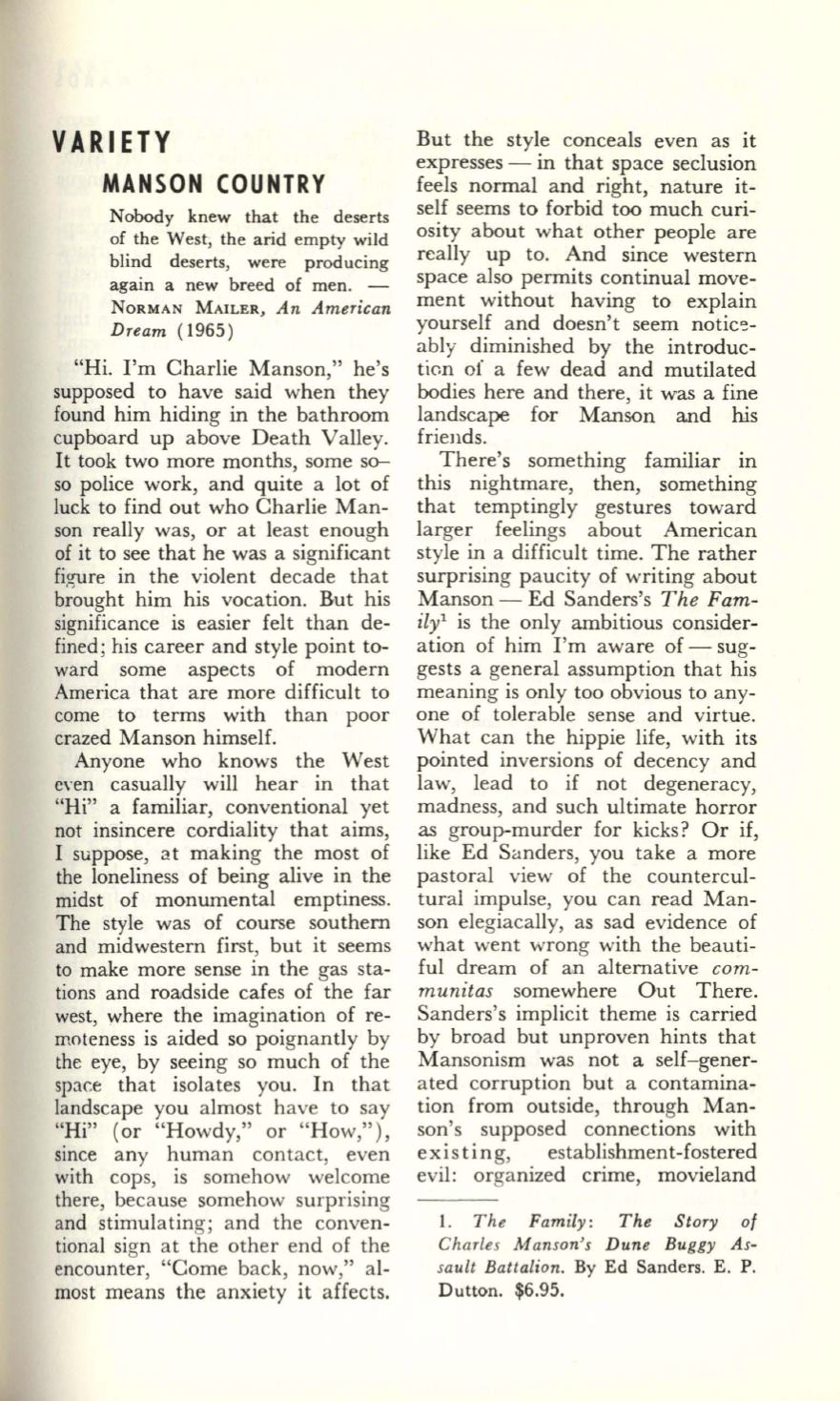
VARIETY
MANSON COUNTRY
Nobody knew that the deserts
of the West, the arid empty wild
blind deserts, were producing
again a new breed of men. -
NORMAN MAILER,
An American
Dream
(1965)
"Hi. I'm Charlie Manson," he's
supposed to have said when they
found him hiding in the bathroom
cupboard up above Death Valley.
It took two more months, some so–
so police work, and quite a lot of
luck to find out who Charlie Man–
son really was, or at least enough
of it to see that he was a significant
figure in the violent decade that
brought him his vocation. But his
significance is easier felt than de–
fined; his career and style point to–
ward some aspects of modern
America that are more difficult to
come to terms with than poor
crazed Manson himself.
Anyone who knows the West
cyen casually will hear in that
"Hi" a familiar, conventional yet
not insincere cordiality that aims,
I suppose, at making the most of
the loneliness of being alive in the
midst of monumental emptiness.
The style was of course southern
and midwestern first, but it seems
to make more sense in the gas sta–
tions and rOClJdside cafes of the far
west, where the imagination of re–
moteness is aided so poignantly by
the eye, by seeing so much of the
space that isolates you. In that
landscape you almost have to say
"Hi" (or "Howdy," or "How," ),
since any human contact, even
with cops, is somehow welcome
there, because somehow surprising
and stimulating; and the conven–
tional sign at the other end of the
encounter, "Come back, now," al–
most means the anxiety it affects.
But the style conceals even as it
expresses - in that space seclusion
feels normal and right, nature it–
self seems to forbid too much curi–
osity about what other people are
really up to. And since western
space also permits continual move–
ment without having to explain
yourself and doesn't seem notic"!–
ably diminished by the introduc–
tion of a few dead and mutilated
bodies here and there, it was a fine
landscape for Manson and his
friends.
There's something familiar in
this nightmare, then, something
that temptingly gestures toward
larger feelings about American
style in a difficult time. The rather
surprising paucity of writing about
Manson - Ed Sanders's
The Fam–
ily'
is the only ambitious consider–
ation of him I'm aware of - sug–
gests a general assumption that his
meaning is only too obvious to any–
one of tolerable sense and virtue.
What can the hippie life, with its
pointed inversions of decency and
law, lead to if not degeneracy,
madness, and such ultimate horror
as group-murder for kicks? Or if,
like Ed Sanders, you take a more
pastoral view of the countercul–
tural impulse, you can read Man–
son elegiacally, as sad evidence of
what went wrong with the beauti–
ful dream of an alternative
com–
munitas
somewhere Out There.
Sanders's implicit theme is carried
by broad but unproven hints that
Mansonism was not a self-gener–
ated corruption but a contamina–
tion from outside, through Man–
son's supposed connections with
existing,
establishment-fostered
evil: organized crime, movieland
1.
The Family : The Story of
Charles M anson's Dune Buggy As–
sault Battalion.
By Ed Sanders. E. P.
Dutton. $6.95.


